The OnePlus 3 Review
by Brandon Chester on June 20, 2016 8:00 AM EST- Posted in
- Smartphones
- OnePlus
- OnePlus 3
GPU Performance
GPU performance is one of the areas where Snapdragon 810 actually tended to do quite well. It's also the case that GPUs generally see larger performance gains year over year than CPUs. We already saw how Adreno 530 performs in the LG G5 review, but the device being compared to was the LG G4, which used Snapdragon 808. The OnePlus 3 represents an opportunity to compare a Snapdragon 810 device to its successor using Snapdragon 820.
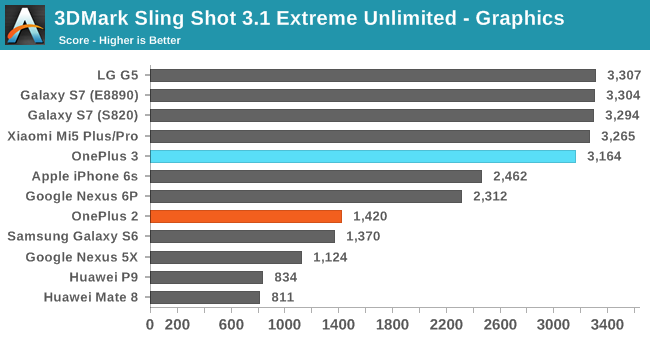
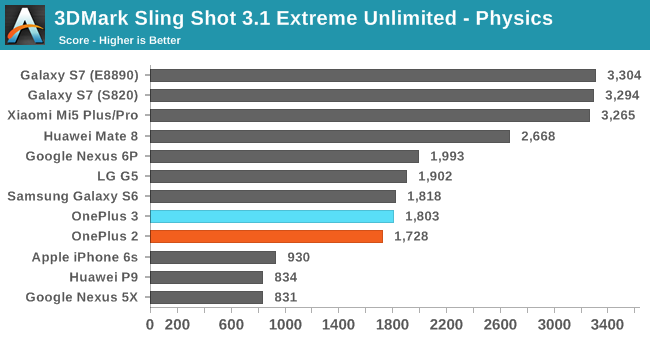
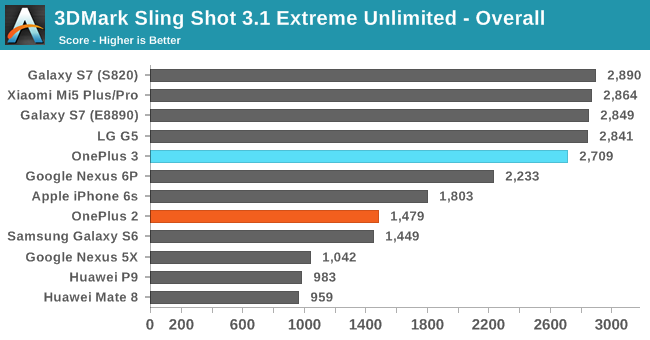
The OnePlus 3 does very well in 3DMark Sling Shot. In both the physics and graphics tests it trails the LG G5 slightly, but the gap isn't anything truly significant. Exynos 8890 is still not something I can compare to until our Galaxy S7 review is posted, but barring that it's clear that Snapdragon 820's Adreno 530 gives the fastest smartphone performance in this test, and when looking at the graphics performance the performance is over two times faster than the OnePlus 2.
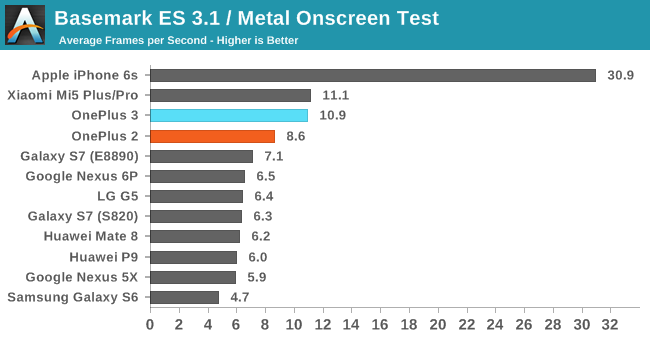
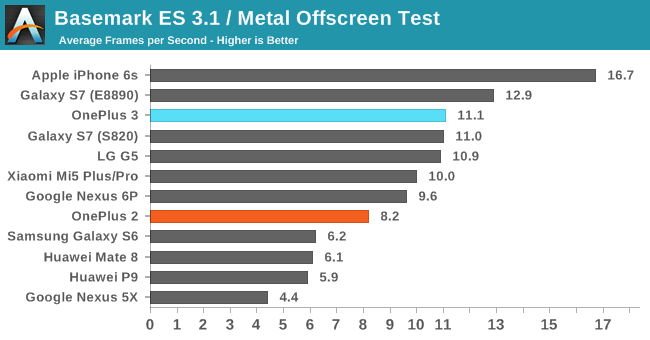
In BaseMark ES 3.1's on screen test the OnePlus 3 manages a significant lead over the LG G5 as a result of its lower resolution. In the off screen 1080p test both phones have essentially the same performance, which is what you'd expect. It looks like Adreno 530 doesn't make the same gains in this test that it does in some others, and it's not clear whether this is just the result of driver optimizations or something about the benchmark that is able to perform batter on other GPU architectures, which could be contributing to the iPhone's lead even in the off screen test.

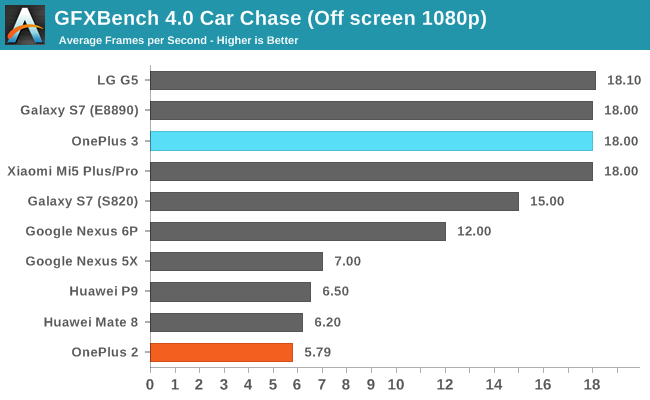
In GFXBench Car Chase the performance of the OnePlus 3 is in line with the LG G5. On screen performance is significantly higher due to the lower resolution display, while off screen performance at 1080p is about the same as the G5 and exactly the same as the on screen result. As far as absolute GPU performance goes, both of our Snapdragon 820 devices are at the top of the chart for absolute performance, and that's good news for anyone playing games or using software that benefits from a powerful mobile GPU.
NAND Performance
The OnePlus 3 moves to a UFS 2.0 NAND solution, which OnePlus claims is three times faster than the eMMC storage used in the OnePlus 2. In more realistic testing you probably won't end up achieving speeds three times faster than the OnePlus 2 since it actually wasn't slow at all by eMMC standards, but there should be a decent uplift in NAND performance nonetheless.
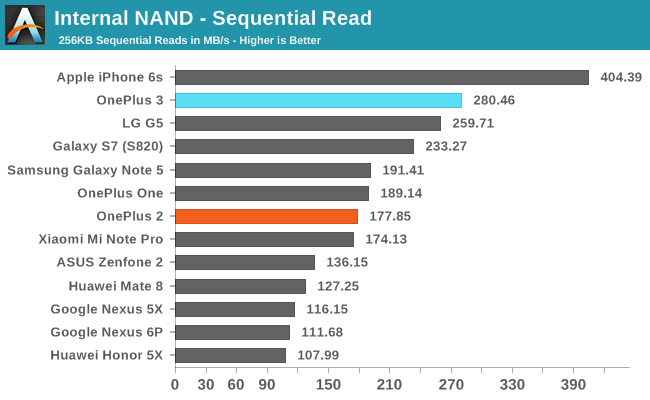
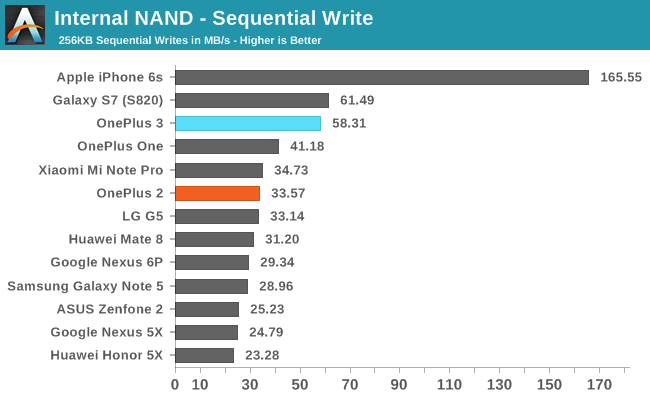
The move to UFS 2.0 brings healthy gains over the OnePlus 2's storage performance, although as I said, the OnePlus 2 didn't perform poorly at all by the standards of eMMC devices. Sequential read and write performance is actually the best that I've measured so far on an Android device. We're still not looking at anything close to what you get for sequential performance on iOS devices, but there are some other factors at play like the fact that the iPhone was a 128GB unit while our Android devices are usually 32GB or 64GB devices. In any case, the OnePlus 3 doesn't present any problems with storage performance, and you certainly won't run into the same issues that you can with budget smartphones at the $200-300 range where the eMMC solutions can be exceptionally slow.










176 Comments
View All Comments
pcpoweruser - Monday, June 20, 2016 - link
You are simply not getting something - display accuracy has very little to do with sRGB color space itself. sRGB is a relatively dull, limited colorspace that defines collors far bellow what human eyes can see and it only exists because wider gamut was problematic to achieve on pre-OLED displays. AdobeRGB (that OLEDs can reach) is far richer, vibrant closer to life color space.Personally, I would never use modern, wide-gamut OLED display in crippled sRGB mode that essentially limit panel ability do render deep, saturated colours, it is just not 'fun'. Many of these colors are just UI elements, icons, etc - they look much nicer with wide gamut. Yes, I cannot believe that Android still does not have any form of color management built in and think it is a total disgrace. As a result, the cost of using full abilities of wide gamut displays is that photos (typically designed to be shown on sRGB display) will look oversaturated, even if they are embedded with proper sRGB/AdobeRGB profile, as Android simply have no way to process it. However, to be fair, I a can live with this - I am not a photographer and do not need accurate saturation in photos on my mobile.
But to the point: AdobeRGB (that many OLEDs target) is essentially extension of sRGB, so on OS that does not understand color management, photos with sRGB profile would simply look more saturated - but the colors would be still accurate (i.e certain share of red would be still the same shade, just more intense). NTSC that Oneplus 3 panel seems to target is a different gamut, that is 'shifted' in space (look at CIE graphs), so for instance orange might become red - and this is a problem.
Additionally, there is another aspect of accuracy: balance of individual primary colours at various intensity steps (so called 'greyscale') - and this is quite broken in Oneplus 3 too (yes, I have got one) - blue is dominating heavily pretty much all the intensity steps.
Combined with a very high color temperature ('balance' option in the UI does not help much, it just adds hideous pink hue) and low ~800p real resolution thanks to pentile pattern (with all the artifacts like diamond-shaped fill and color fringing at hight contrast edged) the result is simple - the display is objectively very bad.
My point of reference is to N6P panel, which is absolutely gorgeous, accurate and ultra sharp in comparison.
It is a shame, as otherwise phone is great (build quality, SoC, fast storage), but looking at the screen is just too painful for me - so I am sending it back.
I understand that possibly less than 1% really care about quality of the display, but I am one of those people and totally agree with the reviewer here.
grayson_carr - Tuesday, June 21, 2016 - link
You've missed my point entirely, which was to request that Anandtech provide measurements for displays as they are calibrated out of the box. By default, the Galaxy S7 and Nexus 6P are just as bad, calibration wise, as the OnePlus 3. They are not calibrated to any standard. Not sRGB, not Adobe RGB. Yes there are sRGB modes on both the S7 and 6P, which are what Anandtech tests and publishes results for, and there is also an Adobe RGB mode for the S7, but when you take those phones out of the box, the calibration of each is truly awful, just like the OnePlus 3. Uhg, and you're acting like the 6P has some great panel. God, the 6P screen is sharp and accurately calibrated (in sRGB mode), sure, but it has a horrible grainy look to it and has awful sunlight visibility in sRGB mode (sunlight visibility in the default inaccurate mode is fine, but it's truly terrible in sRGB mode). I own an S7 Edge, OnePlus 3, and Nexus 6P because I'm an Android app developer, so I can compare them all side by side here.pcpoweruser - Tuesday, June 21, 2016 - link
You are missing my point too: 6P in default mode is fine - it targets colour space similar to AdobeRGB, so colors are just more saturated, but they are still the same colors. There is no reason to use sRGB mode on 6P (as you mentioned it impacts maximum brightness badly - like any color curve adjustment) unless you are a photographer and work with sRGB photos on your workstation - by using sRGB mode you are simply crippling display capability to show wide gamut.Oneplus 3 is different, by default it targets odd gamut that actually shitfs colors and make them very different colors - this does not happen 6P. Not to mention terrible white balance and greyscale, which is just fine on 6P in non-sRGB mode. Grainy look on 6P display: is this a joke? Maybe with some dodgy screen protector. It is one of the sharpest, cleanest displays and makes Oneplus 3 look absolutely terrible in comparison.
grayson_carr - Wednesday, June 22, 2016 - link
"colors are just more saturated, but they are still the same colors"What? Not to me. If you take a color and make it way more saturated, it is not the same color. I guess you're saying green will still be green, etc, but just more saturated. I get that. But it still makes photos look untrue to life if the colors are all oversaturated. And even if I accept your explanation for the 6P, what about the S7 and Note 5? The default adaptive mode on those phones is NOT sRGB nor Adobe RGB. It's Samsung's made up colors that they think look good and it's no better than what we see on the OnePlus 3. If Anandtech would test these modes we would see that, which is why I want Anandtech to start testing and discussing them.
Buk Lau - Monday, June 20, 2016 - link
maybe because other so called "reviews" don't even have a colorimeter to properly test displays? subjectively saying "oh it looks good to me" doesn't mean much to everyonegrayson_carr - Monday, June 20, 2016 - link
The display is only 'bad' from a color accuracy standpoint. I actually have the phone, and also own a Galaxy S7 Edge and Nexus 5X. Subjectively, if you hand a random person on the street all three of these phones, they would probably say the OnePlus 3 display looks the best. The Nexus 5X is technically the most accurate, but looks washed out next to the other two to your average person who doesn't deal with color accurate displays for a living. The S7 Edge (mine anyways) has whites that lean too much towards green, so it looks kind of unnatural. I thought the lower resolution of OnePlus 3 would bother me because the display is pentile, but honestly, the screen density it set such that I never bring the phone close enough to my face to notice. Also, while I don't have a measurement device, I think the white balance of my OnePlus 3 is not as cool as the one Anandtech received. Comparing it to other phones, I would guess my sample is more in the 7500K range. Brandon also seems to have missed the color temperature slider in the display settings. I wonder if he had adjust the color temperature a bit warmer if the color measurements would have been a little better.grayson_carr - Monday, June 20, 2016 - link
Oh, I forgot to mention, if you like how the Galaxy S6, S7 and Note 5 displays look in their default adaptive display mode, you will probably like how the OnePlus 3 display looks because it looks very similar to that. Unfortunately, Anandtech and everyone else only test the color accuracy of Samsung displays after changing the display mode to basic / sRGB, which almost no one uses in reality. So you will hear the Galaxy S7 display is suuuupppppeeeerrrr accurate, blah, blah, blah!!! But if you go out and survey actual Galaxy S7 owners on the street, 99.9% of them will be using the default display setting that is not accurate at all and probably no more accurate than the OnePlus 3 display, yet people still say it looks great. So bottom line, don't write of the OnePlus 3 because Anandtech hates the display.Buk Lau - Tuesday, June 21, 2016 - link
it's ok, we get it, you are trying to defend your purchase. Idk if you have read any of those reviews you mentioned so far (probably not as you are still saying these), but in N6P review they clearly gave out results for both profiles. also what you are forgetting is that this is not simply a color profile issue, 1+ just straight up didn't calibrate these panels out of the box. what people like is different from what something objectively is. you can like the 1+3 and its poorly calibrated panels, but that doesn't change the fact that the panel is inaccurate. there's a reason why these standards exist, and just because you don't like the standard doesn't mean it's important.grayson_carr - Wednesday, June 22, 2016 - link
Why would I need to defend my purchase? I own a Galaxy S7 edge and will be keeping it as my main phone and returning the OnePlus 3. I only bought a OnePlus 3 because I am an Android app developer and phone enthusiast and just like trying all of the new phones. That's great that they gave out results of both profiles for the 6P, but if I remember correctly, it's only because they tested the default profile before they discovered the sRGB mode. They never test the default profile of Samsung phones. I want them to call Samsung out for shipping phones with displays that are so inaccurate out of the box. Yeah, it's great that Samsung gives you an accurate profile setting, but when you just test that and don't even mention the default profile, it confuses people and makes most people think Samsung displays are accurate right out of the box. Even many reviewers at other popular sites obviously don't know that Samsung displays are onky accurate in basic mode.grayson_carr - Wednesday, June 22, 2016 - link
there's a reason why these standards exist, and just because you don't like the standard doesn't mean it's important.Wtf dude? You've got me all wrong. I'm a proponent of sRGB. I like it and wish all phones were calibrated to that standard out of the box. That said, if you're going to completely trash a phone for not being calibrated to sRGB out of the box, you need to trash every phone that isn't calibrated to that out of the box to some extent, but Samsung just throws in an sRGB profile that no real world users even know about and gets away with shipping displays that aren't calibrated to any standard at all by default (cough... adaptive mode)???